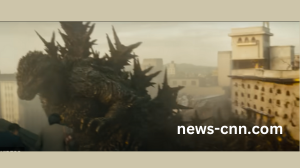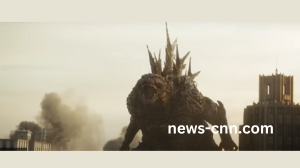“Godzilla Minus One” unfolds as more than just a monster movie—it’s akin to a heartfelt 1950s romantic melodrama. The narrative delves into the lives of Koichi (Ryunosuke Kamiki), a former kamikaze pilot haunted by guilt, and Noriko (Minami Hamabe), his unconventional partner, as they navigate post-World War II Tokyo while raising a child. Their unique connection weaves through the challenges of life in a war-ravaged city, with leaky roofs, scarce work, and Koichi grappling with what we now recognize as PTSD.
Amidst these challenges, a 200-foot-tall lizard decides to terrorize the country.
In this 1954 “Godzilla” reboot, filmmaker Takashi Yamazaki got the roles of writer, director, and visual effects supervisor. He skillfully blends the familiar beats of a modern blockbuster with the emotional and political resonance of the original, resulting in a visually enchanting and thoroughly entertaining epic.

The film begins on an isolated airstrip during the war’s final days, with a mysterious creature attacking. Unlike recent Godzilla adaptations emphasizing sheer size, Yamazaki opts for suspense, returning the kaiju to its horror roots. This Godzilla is terrifying, a slow but sure force inching towards the audience, amplifying fear.
Unlike recent American Godzilla films, “Minus One” places ordinary people at the forefront, tasked with stopping Godzilla from elevating the emotional stakes. The film thrives on this emotional investment, particularly in the first hour, focusing on the deep connection between Koichi and Noriko. Their relationship unfolds against the backdrop of a crumbling city, laying the foundation for the intense sentiment crucial in the second half.
Even as Godzilla returns to the scene, the film delicately nurtures its tender core. The locations of urban devastation are expertly choreographed and beautifully shot by Kozo Shibasaki. While the film’s budget may be modest, most of the effects, including Godzilla’s awe-inspiring “atomic breath,” are skillfully crafted.
See now that Godzilla Minus One isn’t so hard, is it?
Beyond the spectacle, the Godzilla franchise has always carried political undertones, critiquing the Atomic Age and Japan’s military policies. “Minus One” maintains this tradition, with Tokyo sequences eerily reminiscent of Hiroshima and Nagasaki, layered with criticism of the imperial government and the army’s self-sacrifice embodied by Koichi’s refusal to “die honourably.”
The final act showcases blockbuster filmmaking at its pinnacle. Naoki Sato’s score builds as repurposed Navy cruisers engage with Godzilla in open water. The action sequences operate like symphonies, orchestrated perfectly by Yamazaki, resulting in catharsis akin to the finest works of action directors like Kathryn Bigelow, James Cameron, and Christopher McQuarrie.
In a cinematic landscape where concise, creative action coupled with emotionally resonant characters continues to captivate audiences, “Godzilla Minus One” is a compelling testament. With a PG-13 rating and a unique blend of creature violence, action, and heartfelt storytelling, this Japanese film with subtitles runs for 125 minutes, leaving an indelible mark on monster movie enthusiasts and romantics alike.



